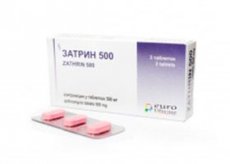Medical expert of the article
New publications
Preparations
Zatrine
Last reviewed: 23.04.2024

All iLive content is medically reviewed or fact checked to ensure as much factual accuracy as possible.
We have strict sourcing guidelines and only link to reputable media sites, academic research institutions and, whenever possible, medically peer reviewed studies. Note that the numbers in parentheses ([1], [2], etc.) are clickable links to these studies.
If you feel that any of our content is inaccurate, out-of-date, or otherwise questionable, please select it and press Ctrl + Enter.

Zatrine - antibacterial agent for systemic use, belongs to the group of antibiotics-macrolides. ATS code is J01F A10. Manufacturer - FDC Limited (India). Other trade names: Azithromycin, Azitrox, Sumamed, Sumamecin, Sumamox, Zitrolide, Zitrocin, Hemomycin.
Indications of the zatrine
Zatrine is used in otolaryngology for the treatment of pharyngitis, tonsillitis, sinusitis, bronchitis, otitis, pneumonia caused by bacterial infections; in dermatology - for the treatment of erysipelas, impetigo, pyoderma (including staphylococcus sycosis), ecthyma, bacterial balanitis; in urology - for the therapy of urethritis, chlamydial cervicitis and colpitis.

Release form
Zatrin is available in the form of 500 mg tablets.
Pharmacodynamics
The mechanism of bactericidal action of the drug Zatrin provides its active substance - antibiotic azithromycin. It penetrates the prokaryotic lysosomes and neutralizes the enzymes of the large subunit of the cell ribosome (50S), which catalyze the transpeptiation reaction. As a result, the assembly of polypeptide chains of proteins in bacterial cells ceases, binding to the matrix RNA becomes impossible, and thus the process of bacterial multiplication stops.
Zatrine is active against gram-positive aerobes (Staphylococcus aureus, Streptococcus pneumoniae, Streptococcus pyogenes), gram-negative aerobes (Haemophilus, Legionella pneumophila, Moraxella catarrhalis) and anaerobic bacteria (Clostridium perfringens, Fusobacterium, Prevotella).
Pharmacokinetics
After oral administration, Zatrin is rapidly adsorbed in the gastrointestinal tract and enters the bloodstream. But with the plasma proteins, the drug binds slightly, falling mainly in the tissue. The highest serum concentration of the drug is observed on average 2.5 hours after admission; the bioavailability of the active substance is about 37%.
More than 85% of the drug undergoes biotransformation in the liver (by demethylation and hydroxylation) with the formation of inactive metabolites. The rest is excreted by the kidneys unchanged. Excretion is produced by the intestine and kidneys.
The removal of the active substance from the plasma lasts up to 20 hours, from the tissues - up to 24-72 hours, so Zatrin is taken once every 24 hours.
Use of the zatrine during pregnancy
Use during pregnancy is not recommended.
Contraindications
Contraindications to the use of Zatrin are individual hypersensitivity to antibiotics of this group, as well as expressed violations of the liver and kidneys.
 [9]
[9]
Side effects of the zatrine
Application Zatrine can cause nausea, vomiting, diarrhea, flatulence, abdominal cramps, dizziness and fatigue, allergic reactions (skin rashes and itching), reversible vision impairment, distortion or loss of taste and smell. Among the rarer possible side effects of this drug are oral and vaginal candidiasis, eosinophilia, leukopenia, psychomotor hyperactivity, palpitations and chest pain, decreased liver and kidney function, and joint pain.
As with other antibacterial drugs, there is a possibility of superinfection (mycosis), as well as changes in normal flora of the colon with an increase in the growth of strains of Clostridium difficil.

Interactions with other drugs
Bioavailability Zatrin decreases with simultaneous administration of antacids (preparations for the treatment of heartburn in acid-dependent gastrointestinal diseases).
With caution combine Zatrine with other antibiotic-macrolides, in particular, derivatives of cyclosporine. Levomycetin (chloramphenicol) and tetracyclines increase Zatrine's effectiveness, and lincomycin and clindamycin weaken.
The use of indirect anticoagulants (warfarin), as well as coumarin oral anticoagulants may increase the risk of bleeding when using Zatrine. Simultaneous use of Zatrine and heparin is incompatible.
Storage conditions
Shelf life
36 months.

Attention!
To simplify the perception of information, this instruction for use of the drug "Zatrine" translated and presented in a special form on the basis of the official instructions for medical use of the drug. Before use read the annotation that came directly to medicines.
Description provided for informational purposes and is not a guide to self-healing. The need for this drug, the purpose of the treatment regimen, methods and dose of the drug is determined solely by the attending physician. Self-medication is dangerous for your health.

